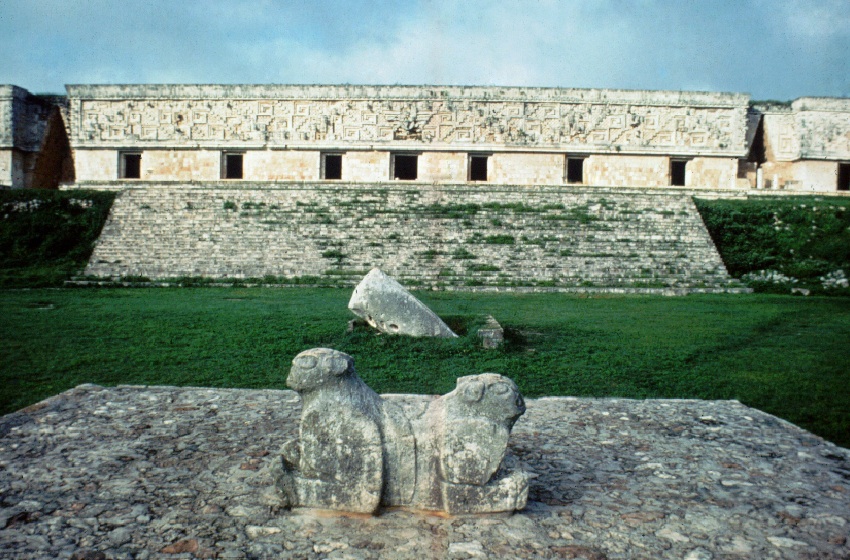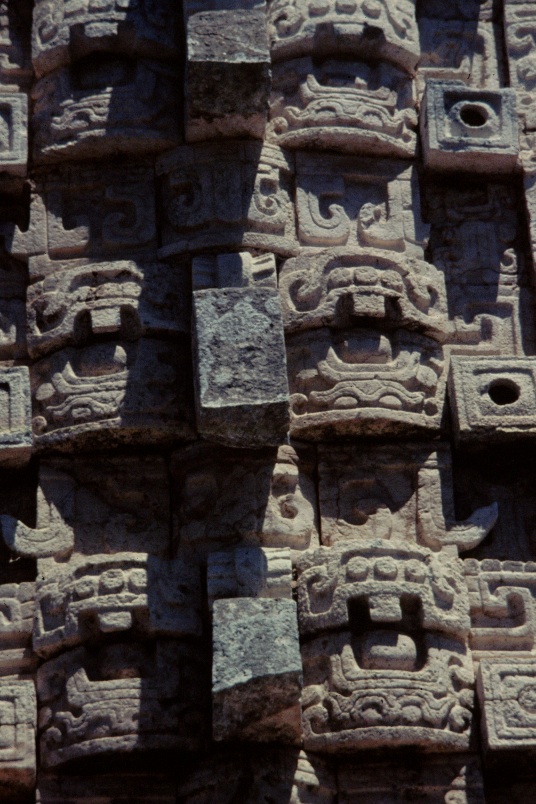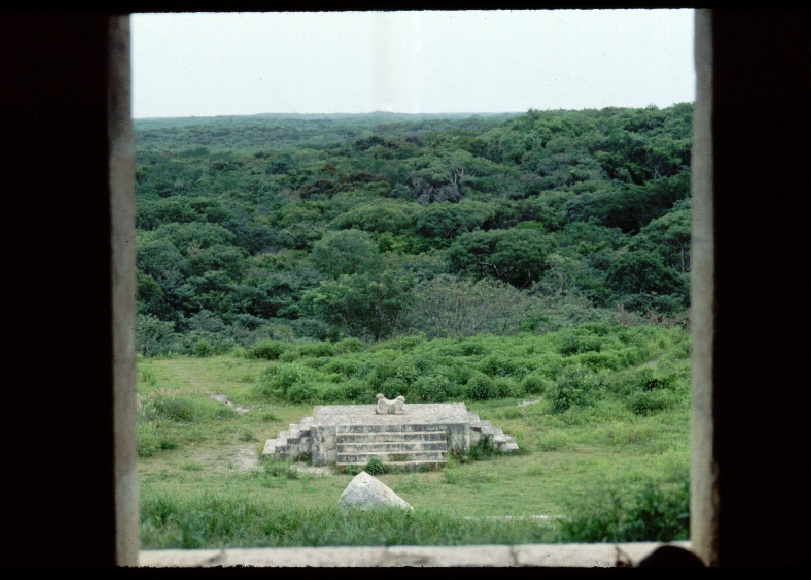Hawkins’ Conclusion
DIGITAL EFFECT: Slow Sunset. Slow diurnal motion so that sunset can be marked accurately.
Will whoever is closest to the sunset point mark it for us please?
We have now marked the four most extreme risings and settings of the Sun, the farthest north and the farthest south. We are now ready for the final test. If Stonehenge does indicate these directions in the main four alignments, we will have established that Stonehenge could have been used as an astronomical calendar.
DIGITAL EFFECT: Stonehenge Panorama and Trilithons Fade on the symbolic Stonehenge panorama and trilithons, as viewed from the center of Stonehenge, to confirm the alignment of the Sun’s rising and setting position on the summer solstice date.
Well—remarkably good agreement! Within a degree or so, the stones do mark the sunrise and sunset extremes.
Why might Stonehenge have been built with solar alignments?
Why might it have been so important for the ancient builders of Stonehenge to know for sure when the shortest or longest days of the year had arrived?
[If the participants do not respond, you might suggest that the builders were farmers and/or herders. This will usually spark ideas about marking dates for harvesting, transferring animals, etc. You might add that people may even have migrated in those days since they had no way to avoid extremes of weather (no heating or air-conditioning.]
A calendar like Stonehenge is useful since weather is likely to be unpredictable, and a long Indian Summer might leave you stranded in snow if you didn’t realize how late in the season it was.
Because many of the archway openings leave a degree or more of uncertainty, the accuracy of these horizon markings would not have made a very precise calendar.
Fade off the Stonehenge Panorama, Trilithons, and Suntrail.
Ceremony and religion have always been important, however, so it is more likely that Stonehenge could have been a ceremonial site incorporating the motions of the Sun in its design.
DIGITAL EFFECT: Summer Night. Run diurnal motion forward to midnight on -1500/07/09 over 30 seconds. Fade off the clock and cardinal points.
Professor Hawkins has been rewarded for asking the right questions. Both the planetarium and his computer have verified that the alignments he found could have astronomical importance. We have seen that four main alignments mark sunrise and sunset on shortest and longest days of the year. The other six alignments turn out to coincide approximately with six of the eight extreme moonrise and moonset positions. The Moon has a much more complex cycle than the Sun, and there are eight extremes in a period of about 18 years, instead of just four in one year like the Sun.
Gerald Hawkins’ theory and his findings about Stonehenge made him instantly famous, and controversial, among people who had been fascinated by Stonehenge, especially those who had been studying it all their lives. His results were certainly provocative, but there were problems. Hawkins was not trained as an archaeologist, and when he tried to use his findings to say more about the Stonehenge builders, he seemed to be unaware of what more traditional archaeologists had been learning. The alignments he deduced were based on crude maps of Stonehenge; professional archaeologists knew that a better survey was needed for such precise work.
Over the next decade Hawkins’ ideas were challenged, and errors he made were pointed out mercilessly. Much better surveys were done. The system for establishing the dates of Stonehenge (radiocarbon dating) was improved, changing the best date for the beginning of Stonehenge by 800 years. Other investigators recalculated Hawkins’ data and tried his ideas out on other sites, throughout Britain, and also in other countries.
What is the result of all this work? Most researchers in the field now believe that Hawkins’ basic idea was correct, and that one or more astronomical alignments do play a significant role in understanding why Stonehenge was built the way it was. While Hawkins describes Stonehenge as an observatory or primitive computer, most investigators now see Stonehenge more as a ceremonial site which incorporates solar alignments. The Moon alignments, because they are incomplete and also contain large uncertainties, are less convincing.
Perhaps the most important result of Gerald Hawkins’ investigation is that a whole generation of astronomers have learned something about archaeology, and a generation of archaeologists have learned a lot of astronomy. Indeed, there are now investigators with solid knowledge of both fields, who study the new field of “archaeoastronomy” and are revising our ideas about our ancestors.
Optional Section Here is one example of what archaeoastronomy has learned, taken from dozens of exciting discoveries in the Americas. VISUAL 17 (still): Facade of the “Governor’s Palace” at Uxmal [Fade on image of the Governor’s Palace at Uxmal. This ruined but still magnificent building we call the “Governor’s Palace.” It is on the Yucatán peninsula in Mexico. It was the work of the great Mayan civilization which ruled this area for hundreds of years. This building was constructed around 750 AD, in a city called Uxmal (Ush-mall), but it faces the horizon at a different angle from that of the rest of the buildings of that city. Could that angle imply some astronomical alignment?

VISUAL 18 (still): Close-up of the Facade Covered with Choc and Venus Symbols. [Fade on and scale up image of a close-up of the facade at Uxmal.] The front of the building gives a clue. The elaborate carvings repeated hundreds of times show a Mayan god named Chac, who has a big hooked nose. And in each carving his forehead is decorated with a figure made up of disks and a curved line, which is the Mayan symbol of the god, and the planet, which we call Venus. Venus was very important in Mayan religion and ritual, and they kept careful records of its motions. Armed with their new awareness of the importance of astronomy to ancient people, investigators made careful surveys of the building and the surrounding area.

VISUAL 19 (still): View Out from the Central Doorway of the Governor’s Palace. [Fade on and scale up image of the view out of the central doorway of the Governor’s Palace.] Fade off all Uxmal images. Here is the view from the central doorway of the Palace. Looking out over a carved pillar and a small platform, can you see a tiny bump on the horizon? That turned out to be a small pyramid in another Mayan site called Cehtzuc (Kayt-zuc).

The line of sight from the central doorway of the Palace to the tip of that pyramid marks the extreme southernmost rising point of . . . can you guess? [The planet Venus. The accuracy is within 1/30th of one degree.] That is as good as the best Stonehenge alignment (the earthen “avenue” enclosing the Heel Stone), and much more precise than the trilithon alignments, which have an uncertainty of a degree or so. Uxmal was built more than 3,000 years after Stonehenge, on another continent. We are learning that interest and knowledge about astronomy was part of the development of nearly every society on Earth. The three paragraphs which follow are a summary of the topic. You may wish to shorten this for younger students, or enrich it with material from the bibliography which follows, for older students or students with special interests in, for example, Native Americans.The astronomical experiment you have just done is perhaps a part, but only a part, of the answer to a centuries-old puzzle. Stonehenge was probably a dramatic stage for religious ceremonies, and those may well have been astronomically-timed. Sunrise on the longest day of the year, marked with great accuracy by an earthen “avenue” which encloses the Heel Stone, is universally agreed to be a deliberate astronomical alignment. Hawkins’ trilithon alignments, which we have explored, remain controversial, however.
The Heel Stone itself marks the solstice sunrise today, but would not have been an accurate marker at the time when Stonehenge was built. There has been speculation that the Heel Stone has tilted over since its original installation, or that there were one or more other stones, now missing, which along with the Heel Stone would have framed an accurate solstice alignment.
DIGITAL EFFECT: Conclusion – Daylight. Fast forward to approximately 45 minutes past sunrise with atmosphere on. If possible and desired, turn on clouds. DIGITAL EFFECT: Time Zone. Set the time zone to back to your home time zone.
Mysteries remain, and we continue to wonder about the people who built and used Stonehenge. The construction, from placement of the first stone to the completion of various rings of stones, took more than a thousand years and involved different cultures in different eras. How much about the uses and the astronomy of Stonehenge was passed on from builder to builder? How much was invented or reinvented throughout that millennium?
Some astronomers, including Hawkins, have credited these ancient peoples with even more complex knowledge. They suggest that the Stonehenge builders used other features of Stonehenge to predict eclipses with considerable accuracy, although few investigators accept this hypothesis. Alexander Thom, a civil engineer who doubted Hawkins’ theories and criticized his crude maps, systematically surveyed hundreds of ancient sites. He found many with astronomical alignments, and has even suggested that neolithic people had a standard of length, centuries before the first known standards.
We hope you have enjoyed our excursion into the new science of archaeoastronomy. It is a wonderful example of how careful, persistent investigators, starting out with only a vague idea and little hard data, can teach themselves to see in a new way how our ancestors have looked at the universe.

